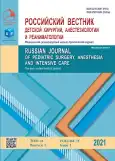Closed kidney injuries in children
- Authors: Solovyov A.E.1
-
Affiliations:
- Ryazan State medical University
- Issue: Vol 11, No 1 (2021)
- Pages: 63-68
- Section: Original Study Articles
- URL: https://journals.rcsi.science/2219-4061/article/view/123500
- DOI: https://doi.org/10.17816/psaic567
- ID: 123500
Cite item
Full Text
Abstract
MATERIALS AND METHODS: Within 20 yrs, 76 children aged 2–8 yrs with kidney trauma were under observation, and 35 of them had associated trauma. Clinical, instrumental, and radiological methods were used in the diagnosis.
RESULTS: Of the 76 children with closed kidney trauma, 23 were diagnosed with kidney contusion, 14 with kidney injury with subcapsular hematoma, 16 with kidney injury with rupture of the capsule and perirenal urohematoma, 21 with kidney rupture and damage to the calyx–pelvic system, and 2 with traumatic hydronephrotic kidney. Conservative treatment was carried out in 49 (64.4%) children and surgical treatment in 28 (25.6%). In the long term, 28 children with kidney injuries and treated conservatively were examined. Complications were found in nine children: pyeloectasia, deformation of the calyx–pelvic system, pyelonephritis, and renal hypertension. Organ-preserving surgery was performed in 22 (28.9%) children and nephrectomy in 5 (6.6%) children. As long-term results: the function of the operated kidneys was satisfactory, some changes occurred in the calyx–pelvic systems, and no data for pyelonephritis was found.
CONCLUSION: Renal injuries with subcapsular rupture and perirenal urohematoma should be surgically treated to prevent severe long-term complications. In unclear cases, the choice can be a two-stage organ-preserving operation for the so-called crushing of the kidney.
Keywords
Full Text
##article.viewOnOriginalSite##About the authors
Anatoly E. Solovyov
Ryazan State medical University
Author for correspondence.
Email: beerzombie@rambler.ru
ORCID iD: 0000-0001-8785-3628
Dr. Sci. (Med.), Professor
Russian Federation, 9 Vysokovol’tnaya str., Ryazan, 390026References
- Isakov YF, Dronov AF. Detskaja hirurgija. Nacional’noe rukovodstvo. Moscow; 2009. 1164 р. (In Russ.)
- Mamatkulov BM, Avezova GS. Congenital anomalies as a cause of childhood disability. Science of young (Eruditio Juvenium). 2015;(2):110–115. (In Russ.)
- Solov’ev AE. Trauma of parenchymal organs of the abdominal cavity and retroperitoneal space in newborns. IP. Pavlov Russian Medical Biological Herald. 2019;27(1):75–79. (In Russ.) doi: 10.23888/PAVLOVJ201927175-79
- Novoselov VP, Savchenko SV, Sakolchyk OA. Assessment of morphological damage of the kidney in establishing the mechanism of intravitality and prescription of the injuries. Forensic medical examination. 2016;59(5):10–13. (In Russ.) doi: 10.17116/sudmed201659510-13
- Rudin YuE. Diagnosis and treatment of traumatic kidney injury in children. Urology. 2006;(6):70–74. (In Russ.)
- Abu-Gazala M, Shussman N, Abu-Gazala S. Endovascular management of blunt renal artery trauma. Isr Med Assoc J. 2013;15(5):210–215.
- Ball CG, Felicano DV, Manox KL. Combined splenectory and nephrectomy for trauma: morbidity, mortality and outcomes over 30 years. J Trauma. 2010;68(3):519–521. doi: 10.1097/TA.0b013e3181cda28d
- Canon S, Recicar J, Head B. The ulility of initial and follow-up ultrasound reevaluation for blunt renal trauma in children and adolescents. J Pediatr Uril. 2014;10(5):815–818. doi: 10.1016/j.jpurol.2014.01.019
- Moore EE, Shackford SR, Pachter HL. Organ injury scaling: spleen, liver, and kidney. J Trauma. 1989;29(12):1664–1666.
- Edwards NM, Claridge JA, Forsythe RM. The morbidity of trauma nephrectomy. Am Surg. 2009;75(11):1112–1117. doi: 10.1177/000313480907501118
- Fischer W, Wanaselia A, Steenburg SD. JOURNAL CLAB: Incidence of Urinary Leak and Diagnostic Yield of Excretory Phase CT in the Setting of Renal Trauma. AJR. Am J Roentgenol. 2015;204(6):1168–1172. doi: 10.2214/AJR.14.13643
- Simmons JD, Haraway AN, Schmieg RE, et al. Blunt renal trauma and the predictors of failure of non-operative management. J Miss State Med Assoc. 2010;51(5)131–133.
- Allazov SA. Damage of kidneys and urinary tract. Urology. 2012;(6):110–113. (In Russ.)
- Breen KJ, Sweeney P, Nicolson PJ. Adult blunt renal trauma: routine follow-up imaging is exessive. Urology. 2014;84 (1):62–67. doi: 10.1016/j.urology.2014.03.013
- Kikuchi M, Kameyama K, Hotie K. Conservative management of symptomatic or asymptomatic urinoma after grade III blunt renal trauma: a report of three cases. Hinyokika Kiyo. 2014;60(12):615–620.
- Aragona F., Pepe P., Patanè D. Management of sever blunt renal trauma in adult patients: a 10-year retrospective review from an emergency hospital. BJU Int. 2012;110(5):744–748. doi: 10.1111/j.1464-410X.2011.10901.x
- Hardee MJ, Lowrance W, Brant WO. High grade renal injuries: application of Parkland Hospital predictors of intervention for renal hemorrhage. J Urol. 2013;189(5):1771–1776. doi: 10.1016/j.juro.2012.11.172
- Morey AF, Brandes S, Dugi DD. 3rd. Urotrauma: AUA guideline. J Urol. 2014;192(2):327–335. doi: 10.1016/j.juro.2014.05.004
- Kazakova SS, Kolesov VYu, Khazov PD. Radiation diagnostics in Pediatrics. Ryazan: RIO PyazGMU; 2014. 207c. (In Russ.)
- Finkelson EI, Petlakh VI. Clinic and diagnosis of closed combined kidney injury in children. Bulletin of Surgery. 1980;124(2):127–131. (In Russ.)
- Dovlatyan AA., Cherkasov YuV. Results of treatment of isolated and combined trauma of the genitourinary system. Surgery. 2003;5:53–58. (In Russ.)
- Smolyar AN. Closed abdominal trauma. Kidney damage. Part 3. Surgery. 2016;6:4–13. (In Russ.). doi: 10.17116/hirurgia201664-13
- Ternovsky SK, Vasiliev AYu. Luchevaja diagnostika v pediatrii. Moscow: GEOTAR-Media; 2010: 237–242. (In Russ.)
- Lopatkin NA. Urologija. Nacional’noe rukovodstvo. Moscow: GEOTAR-Media; 2010. 1064 р. (In Russ.)
Supplementary files






